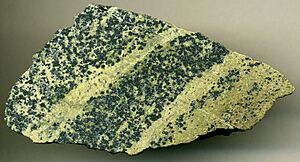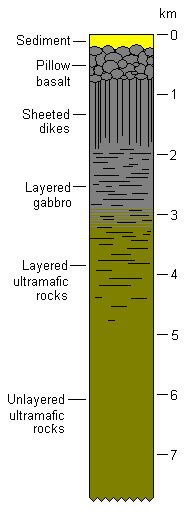Ophiolite facts for kids

An ophiolite is like a special piece of the Earth's deep oceanic crust and the rock beneath it, called the upper mantle. These pieces have been pushed up and are now found on land, often in mountain ranges. The rocks that make up ophiolites are usually a changed type of basalt, and they often look green.
You can find ophiolites in big mountain belts, like the Alps or the Himalayas. They are important because they show us where old ocean floors used to be, before they were pulled under the Earth's surface in a process called subduction. Studying ophiolites helped scientists understand plate tectonics, which is the theory of how the Earth's large plates move.
What an Ophiolite Is Made Of
Ophiolites have a special layered structure, almost like a stack of different rocks. This structure forms when new lithosphere (the Earth's rigid outer layer) is created at mid-oceanic ridges, which are underwater mountain ranges where new ocean floor forms.
Here are the layers you might find in an ophiolite, from top to bottom:
- Sediments: These are the top layers, often made of muds (like black shale) and cherts. They settled on the ocean floor after the crust was formed.
- Extrusive Sequence: Below the sediments, you'll find basalt "pillow lavas." These rocks look like stacked pillows because they formed when hot magma erupted underwater and quickly cooled as it touched the cold seawater.
- Vertical Dikes: Under the pillow lavas are many parallel, vertical rock layers called dikes. These were pathways for the magma to flow up from below and form the lavas above.
- Gabbros: Deeper down, you'll find rocks called gabbros. These formed from minerals that slowly settled out of a large magma chamber deep beneath the ocean floor.
- Peridotite: At the very bottom, there's peridotite. This is a type of rock that comes from the Earth's mantle. It was heated and put under great pressure during orogeny (mountain-building) events.
Famous Ophiolites Around the World
Some ophiolites are very well-known because they are easy to study or have special features:
- In the California Coast Ranges, you can find ophiolites stretching from Santa Barbara all the way through San Francisco Counties in California.
- The ophiolites in Oman and the United Arab Emirates are considered some of the best examples in the world because they are so well-exposed.
- Macquarie Island, near Tasmania, Australia, was named a UNESCO World Heritage Site in 1997. It's special because it's the only known ophiolite complex that is still forming today in its original ocean setting.
- In Gros Morne National Park, Newfoundland, Canada, there's another UNESCO World Heritage Site. It was recognized in 1987 for its amazing and complete ophiolite layers that are clearly visible.
Images for kids
-
An Ordovician ophiolite in Gros Morne National Park, Newfoundland.
-
Chromitic serpentinite from the Bay of Islands Ophiolite in Lewis Hills, Newfoundland.
-
A simple diagram showing the structure of an ophiolite: 1. magma chamber 2. ocean sediments 3. pillow basalts 4. sheeted basaltic dikes 5. layered gabbro 6. mantle rocks.
-
A classic ophiolite example in Cyprus, showing sheeted lava layers with a dike cutting through them, and pillow lava on top.
See also
 In Spanish: Ofiolita para niños
In Spanish: Ofiolita para niños








